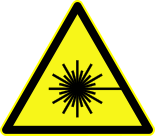Laser

A laser is a device that emits light through a process of optical amplification based on the stimulated emission of electromagnetic radiation. The word laser originated as an acronym for light amplification by stimulated emission of radiation.[1][2] The first laser was built in 1960 by Theodore Maiman at Hughes Research Laboratories, based on theoretical work by Charles H. Townes and Arthur Leonard Schawlow and the optical amplifier patented by Gordon Gould.[3][4][5]
A laser differs from other sources of light in that it emits light that is coherent. Spatial coherence allows a laser to be focused to a tight spot, enabling applications such as optical communication,[6] laser cutting, and lithography. It also allows a laser beam to stay narrow over great distances (collimation), a feature used in applications such as laser pointers, lidar, and free-space optical communication. Lasers can also have high temporal coherence, which permits them to emit light with a very narrow frequency spectrum. Temporal coherence can also be used to produce ultrashort pulses of light with a broad spectrum but durations as short as an attosecond.[7]
Lasers are used in fiber-optic and free-space optical communications, optical disc drives, laser printers, barcode scanners, semiconductor chip manufacturing (photolithography, etching), laser surgery and skin treatments, cutting and welding materials, military and law enforcement devices for marking targets and measuring range and speed, and in laser lighting displays for entertainment. Lasers transport the majority of Internet traffic.[8] The laser is regarded as one of the greatest inventions of the 20th century.[9][10]
Terminology
The first device using amplification by stimulated emission operated at microwave frequencies, and was called a maser, for "microwave amplification by stimulated emission of radiation".[11] When similar optical devices were developed they were first called optical masers, until "microwave" was replaced by "light" in the acronym, to become laser.[12][13][14]
Today, all such devices operating at frequencies higher than microwaves (approximately above 300 GHz) are called lasers (e.g. infrared lasers, ultraviolet lasers, X-ray lasers, gamma-ray lasers), whereas devices operating at microwave or lower radio frequencies are called masers.[15][16]
The back-formed verb "to lase" is frequently used in the field, meaning "to give off coherent light," especially about the gain medium of a laser;[17] when a laser is operating, it is said to be "lasing".[18] The terms laser and maser are also used for naturally occurring coherent emissions, as in astrophysical maser and atom laser.[19][20]
A laser that produces light by itself is technically an optical oscillator rather than an optical amplifier as suggested by the acronym.[21] It has been humorously noted that the acronym LOSER, for "light oscillation by stimulated emission of radiation", would have been more correct.[20][22] Some sources[23][24] refer to the word laser as an anacronym, meaning an acronym so widely used as a noun that it is no longer considered an abbreviation.[25]
Fundamentals

Photons, the quanta of electromagnetic radiation are released and absorbed from energy levels in atoms and molecules. In a lightbulb or a star, the energy is emitted from many different levels giving photons with a broad range of energies. This process is called thermal radiation.[26]: 575
The underlying physical process creating photons in a laser is the same as in thermal radiation, but the actual emission is not the result of random thermal processes. Instead, the release of a photon is triggered by the nearby passage of another photon. This is called stimulated emission. For this process to work, the passing photon must be similar in energy, and thus wavelength, to the one that could be released by the atom or molecule, and the atom or molecule must be in the suitable excited state.[26]: 580
The photon that is emitted by stimulated emission is identical to the photon that triggered its emission, and both photons can go on to trigger stimulated emission in other atoms, creating the possibility of a chain reaction. For this to happen, many of the atoms or molecules must be in the proper excited state so that the photons can trigger them. In most materials, atoms or molecules drop out of excited states fairly rapidly, making it difficult or impossible to produce a chain reaction. The materials chosen for lasers are the ones that have metastable states, which stay excited for a relatively long time. In laser physics, such a material is called an active laser medium. Combined with an energy source that continues to "pump" energy into the material, it is possible to have enough atoms or molecules in an excited state for a chain reaction to develop.
Lasers are distinguished from other light sources by their coherence. Spatial (or transverse) coherence is typically expressed through the output being a narrow beam, which is diffraction-limited. Laser beams can be focused to very tiny spots, achieving a very high irradiance, or they can have a very low divergence to concentrate their power at a great distance. Temporal (or longitudinal) coherence implies a polarized wave at a single frequency, whose phase is correlated over a relatively great distance (the coherence length) along the beam.[27][page needed] A beam produced by a thermal or other incoherent light source has an instantaneous amplitude and phase that vary randomly with respect to time and position, thus having a short coherence length.
Lasers are characterized according to their wavelength in a vacuum. Most "single wavelength" lasers produce radiation in several modes with slightly different wavelengths. Although temporal coherence implies some degree of monochromaticity, some lasers emit a broad spectrum of light or emit different wavelengths of light simultaneously. Certain lasers are not single spatial mode and have light beams that diverge more than is required by the diffraction limit. All such devices are classified as "lasers" based on the method of producing light by stimulated emission. Lasers are employed where light of the required spatial or temporal coherence can not be produced using simpler technologies.
Design
This section needs additional citations for verification. (October 2023) |
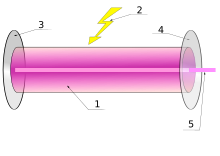
- Gain medium
- Laser pumping energy
- High reflector
- Output coupler
- Laser beam
A laser consists of a gain medium, a mechanism to energize it, and something to provide optical feedback.[28] The gain medium is a material with properties that allow it to amplify light by way of stimulated emission. Light of a specific wavelength that passes through the gain medium is amplified (power increases). Feedback enables stimulated emission to amplify predominantly the optical frequency at the peak of the gain-frequency curve. As stimulated emission grows, eventually one frequency dominates over all others, meaning that a coherent beam has been formed.[29]
The process of stimulated emission is analogous to that of an audio oscillator with positive feedback which can occur, for example, when the speaker in a public-address system is placed in proximity to the microphone. The screech one hears is audio oscillation at the peak of the gain-frequency curve for the amplifier.[30][page needed]
For the gain medium to amplify light, it needs to be supplied with energy in a process called pumping. The energy is typically supplied as an electric current or as light at a different wavelength. Pump light may be provided by a flash lamp or by another laser.
The most common type of laser uses feedback from an optical cavity—a pair of mirrors on either end of the gain medium. Light bounces back and forth between the mirrors, passing through the gain medium and being amplified each time. Typically one of the two mirrors, the output coupler, is partially transparent. Some of the light escapes through this mirror. Depending on the design of the cavity (whether the mirrors are flat or curved), the light coming out of the laser may spread out or form a narrow beam. In analogy to electronic oscillators, this device is sometimes called a laser oscillator.
Most practical lasers contain additional elements that affect the properties of the emitted light, such as the polarization, wavelength, and shape of the beam.[citation needed]
Laser physics
This section needs additional citations for verification. (May 2017) |
Electrons and how they interact with electromagnetic fields are important in our understanding of chemistry and physics.
Stimulated emission
In the classical view, the energy of an electron orbiting an atomic nucleus is larger for orbits further from the nucleus of an atom. However, quantum mechanical effects force electrons to take on discrete positions in orbitals. Thus, electrons are found in specific energy levels of an atom, two of which are shown below:

An electron in an atom can absorb energy from light (photons) or heat (phonons) only if there is a transition between energy levels that match the energy carried by the photon or phonon. For light, this means that any given transition will only absorb one particular wavelength of light. Photons with the correct wavelength can cause an electron to jump from the lower to the higher energy level. The photon is consumed in this process.
When an electron is excited from one state to that at a higher energy level with energy difference ΔE, it will not stay that way forever. Eventually, a photon will be spontaneously created from the vacuum having energy ΔE. Conserving energy, the electron transitions to a lower energy level that is not occupied, with transitions to different levels having different time constants. This process is called spontaneous emission. Spontaneous emission is a quantum-mechanical effect and a direct physical manifestation of the Heisenberg uncertainty principle. The emitted photon has a random direction, but its wavelength matches the absorption wavelength of the transition. This is the mechanism of fluorescence and thermal emission.
A photon with the correct wavelength to be absorbed by a transition can also cause an electron to drop from the higher to the lower level, emitting a new photon. The emitted photon exactly matches the original photon in wavelength, phase, and direction. This process is called stimulated emission.
Gain medium and cavity


The gain medium is put into an excited state by an external source of energy. In most lasers, this medium consists of a population of atoms that have been excited into such a state using an outside light source, or an electrical field that supplies energy for atoms to absorb and be transformed into their excited states.
The gain medium of a laser is normally a material of controlled purity, size, concentration, and shape, which amplifies the beam by the process of stimulated emission described above. This material can be of any state: gas, liquid, solid, or plasma. The gain medium absorbs pump energy, which raises some electrons into higher energy ("excited") quantum states. Particles can interact with light by either absorbing or emitting photons. Emission can be spontaneous or stimulated. In the latter case, the photon is emitted in the same direction as the light that is passing by. When the number of particles in one excited state exceeds the number of particles in some lower-energy state, population inversion is achieved. In this state, the rate of stimulated emission is larger than the rate of absorption of light in the medium, and therefore the light is amplified. A system with this property is called an optical amplifier. When an optical amplifier is placed inside a resonant optical cavity, one obtains a laser.[31]
For lasing media with extremely high gain, so-called superluminescence, light can be sufficiently amplified in a single pass through the gain medium without requiring a resonator. Although often referred to as a laser (see, for example, nitrogen laser),[32] the light output from such a device lacks the spatial and temporal coherence achievable with lasers. Such a device cannot be described as an oscillator but rather as a high-gain optical amplifier that amplifies its spontaneous emission. The same mechanism describes so-called astrophysical masers/lasers.
The optical resonator is sometimes referred to as an "optical cavity", but this is a misnomer: lasers use open resonators as opposed to the literal cavity that would be employed at microwave frequencies in a maser. The resonator typically consists of two mirrors between which a coherent beam of light travels in both directions, reflecting on itself so that an average photon will pass through the gain medium repeatedly before it is emitted from the output aperture or lost to diffraction or absorption. If the gain (amplification) in the medium is larger than the resonator losses, then the power of the recirculating light can rise exponentially. But each stimulated emission event returns an atom from its excited state to the ground state, reducing the gain of the medium. With increasing beam power, the net gain (gain minus loss) reduces to unity and the gain medium is said to be saturated. In a continuous wave (CW) laser, the balance of pump power against gain saturation and cavity losses produces an equilibrium value of the laser power inside the cavity; this equilibrium determines the operating point of the laser. If the applied pump power is too small, the gain will never be sufficient to overcome the cavity losses, and laser light will not be produced. The minimum pump power needed to begin laser action is called the lasing threshold. The gain medium will amplify any photons passing through it, regardless of direction; but only the photons in a spatial mode supported by the resonator will pass more than once through the medium and receive substantial amplification.
The light emitted
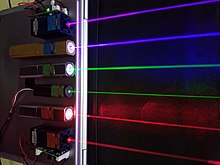
In most lasers, lasing begins with spontaneous emission into the lasing mode. This initial light is then amplified by stimulated emission in the gain medium. Stimulated emission produces light that matches the input signal in direction, wavelength, and polarization, whereas the phase of the emitted light is 90 degrees in lead of the stimulating light.[33] This, combined with the filtering effect of the optical resonator gives laser light its characteristic coherence, and may give it uniform polarization and monochromaticity, depending on the resonator's design. The fundamental laser linewidth[34] of light emitted from the lasing resonator can be orders of magnitude narrower than the linewidth of light emitted from the passive resonator. Some lasers use a separate injection seeder to start the process off with a beam that is already highly coherent. This can produce beams with a narrower spectrum than would otherwise be possible.
In 1963, Roy J. Glauber showed that coherent states are formed from combinations of photon number states, for which he was awarded the Nobel Prize in Physics.[35] A coherent beam of light is formed by single-frequency quantum photon states distributed according to a Poisson distribution. As a result, the arrival rate of photons in a laser beam is described by Poisson statistics.[36]
Many lasers produce a beam that can be approximated as a Gaussian beam; such beams have the minimum divergence possible for a given beam diameter. Some lasers, particularly high-power ones, produce multimode beams, with the transverse modes often approximated using Hermite–Gaussian or Laguerre-Gaussian functions. Some high-power lasers use a flat-topped profile known as a "tophat beam". Unstable laser resonators (not used in most lasers) produce fractal-shaped beams.[37] Specialized optical systems can produce more complex beam geometries, such as Bessel beams and optical vortexes.
Near the "waist" (or focal region) of a laser beam, it is highly collimated: the wavefronts are planar, normal to the direction of propagation, with no beam divergence at that point. However, due to diffraction, that can only remain true well within the Rayleigh range. The beam of a single transverse mode (gaussian beam) laser eventually diverges at an angle that varies inversely with the beam diameter, as required by diffraction theory. Thus, the "pencil beam" directly generated by a common helium–neon laser would spread out to a size of perhaps 500 kilometers when shone on the Moon (from the distance of the Earth). On the other hand, the light from a semiconductor laser typically exits the tiny crystal with a large divergence: up to 50°. However even such a divergent beam can be transformed into a similarly collimated beam employing a lens system, as is always included, for instance, in a laser pointer whose light originates from a laser diode. That is possible due to the light being of a single spatial mode. This unique property of laser light, spatial coherence, cannot be replicated using standard light sources (except by discarding most of the light) as can be appreciated by comparing the beam from a flashlight (torch) or spotlight to that of almost any laser.
A laser beam profiler is used to measure the intensity profile, width, and divergence of laser beams.
Diffuse reflection of a laser beam from a matte surface produces a speckle pattern with interesting properties.
Quantum vs. classical emission processes
The mechanism of producing radiation in a laser relies on stimulated emission, where energy is extracted from a transition in an atom or molecule. This is a quantum phenomenon that was predicted by Albert Einstein, who derived the relationship between the A coefficient, describing spontaneous emission, and the B coefficient which applies to absorption and stimulated emission. In the case of the free-electron laser, atomic energy levels are not involved; it appears that the operation of this rather exotic device can be explained without reference to quantum mechanics.
Modes of operation
This section needs additional citations for verification. (February 2023) |
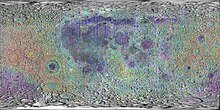
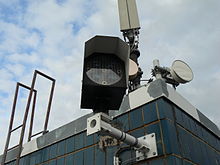

A laser can be classified as operating in either continuous or pulsed mode, depending on whether the power output is essentially continuous over time or whether its output takes the form of pulses of light on one or another time scale. Of course, even a laser whose output is normally continuous can be intentionally turned on and off at some rate to create pulses of light. When the modulation rate is on time scales much slower than the cavity lifetime and the period over which energy can be stored in the lasing medium or pumping mechanism, then it is still classified as a "modulated" or "pulsed" continuous wave laser. Most laser diodes used in communication systems fall into that category.
Continuous-wave operation
Some applications of lasers depend on a beam whose output power is constant over time. Such a laser is known as a continuous-wave (CW) laser. Many types of lasers can be made to operate in continuous-wave mode to satisfy such an application. Many of these lasers lase in several longitudinal modes at the same time, and beats between the slightly different optical frequencies of those oscillations will produce amplitude variations on time scales shorter than the round-trip time (the reciprocal of the frequency spacing between modes), typically a few nanoseconds or less. In most cases, these lasers are still termed "continuous-wave" as their output power is steady when averaged over longer periods, with the very high-frequency power variations having little or no impact on the intended application. (However, the term is not applied to mode-locked lasers, where the intention is to create very short pulses at the rate of the round-trip time.)
For continuous-wave operation, the population inversion of the gain medium needs to be continually replenished by a steady pump source. In some lasing media, this is impossible. In some other lasers, it would require pumping the laser at a very high continuous power level, which would be impractical, or destroying the laser by producing excessive heat. Such lasers cannot be run in CW mode.
Pulsed operation
The pulsed operation of lasers refers to any laser not classified as a continuous wave so that the optical power appears in pulses of some duration at some repetition rate. This encompasses a wide range of technologies addressing many different motivations. Some lasers are pulsed simply because they cannot be run in continuous mode.
In other cases, the application requires the production of pulses having as large an energy as possible. Since the pulse energy is equal to the average power divided by the repetition rate, this goal can sometimes be satisfied by lowering the rate of pulses so that more energy can be built up between pulses. In laser ablation, for example, a small volume of material at the surface of a workpiece can be evaporated if it is heated in a very short time, while supplying the energy gradually would allow for the heat to be absorbed into the bulk of the piece, never attaining a sufficiently high temperature at a particular point.
Other applications rely on the peak pulse power (rather than the energy in the pulse), especially to obtain nonlinear optical effects. For a given pulse energy, this requires creating pulses of the shortest possible duration utilizing techniques such as Q-switching.
The optical bandwidth of a pulse cannot be narrower than the reciprocal of the pulse width. In the case of extremely short pulses, that implies lasing over a considerable bandwidth, quite contrary to the very narrow bandwidths typical of CW lasers. The lasing medium in some dye lasers and vibronic solid-state lasers produces optical gain over a wide bandwidth, making a laser possible that can thus generate pulses of light as short as a few femtoseconds (10−15 s).
Q-switching
In a Q-switched laser, the population inversion is allowed to build up by introducing loss inside the resonator which exceeds the gain of the medium; this can also be described as a reduction of the quality factor or 'Q' of the cavity. Then, after the pump energy stored in the laser medium has approached the maximum possible level, the introduced loss mechanism (often an electro- or acousto-optical element) is rapidly removed (or that occurs by itself in a passive device), allowing lasing to begin which rapidly obtains the stored energy in the gain medium. This results in a short pulse incorporating that energy, and thus a high peak power.
Mode locking
A mode-locked laser is capable of emitting extremely short pulses on the order of tens of picoseconds down to less than 10 femtoseconds. These pulses repeat at the round-trip time, that is, the time that it takes light to complete one round trip between the mirrors comprising the resonator. Due to the Fourier limit (also known as energy–time uncertainty), a pulse of such short temporal length has a spectrum spread over a considerable bandwidth. Thus such a gain medium must have a gain bandwidth sufficiently broad to amplify those frequencies. An example of a suitable material is titanium-doped, artificially grown sapphire (Ti:sapphire), which has a very wide gain bandwidth and can thus produce pulses of only a few femtoseconds duration.
Such mode-locked lasers are a most versatile tool for researching processes occurring on extremely short time scales (known as femtosecond physics, femtosecond chemistry and ultrafast science), for maximizing the effect of nonlinearity in optical materials (e.g. in second-harmonic generation, parametric down-conversion, optical parametric oscillators and the like). Unlike the giant pulse of a Q-switched laser, consecutive pulses from a mode-locked laser are phase-coherent; that is, the pulses (and not just their envelopes) are identical and perfectly periodic. For this reason, and the extremely large peak powers attained by such short pulses, such lasers are invaluable in certain areas of research.
Pulsed pumping
Another method of achieving pulsed laser operation is to pump the laser material with a source that is itself pulsed, either through electronic charging in the case of flash lamps, or another laser that is already pulsed. Pulsed pumping was historically used with dye lasers where the inverted population lifetime of a dye molecule was so short that a high-energy, fast pump was needed. The way to overcome this problem was to charge up large capacitors which are then switched to discharge through flashlamps, producing an intense flash. Pulsed pumping is also required for three-level lasers in which the lower energy level rapidly becomes highly populated, preventing further lasing until those atoms relax to the ground state. These lasers, such as the excimer laser and the copper vapor laser, can never be operated in CW mode.
History
Foundations
In 1917, Albert Einstein established the theoretical foundations for the laser and the maser in the paper "Zur Quantentheorie der Strahlung" ("On the Quantum Theory of Radiation") via a re-derivation of Max Planck's law of radiation, conceptually based upon probability coefficients (Einstein coefficients) for the absorption, spontaneous emission, and stimulated emission of electromagnetic radiation.[38] In 1928, Rudolf W. Ladenburg confirmed the existence of the phenomena of stimulated emission and negative absorption.[39][page needed] In 1939, Valentin A. Fabrikant predicted using stimulated emission to amplify "short" waves.[40] In 1947, Willis E. Lamb and R. C. Retherford found apparent stimulated emission in hydrogen spectra and effected the first demonstration of stimulated emission.[39][page needed] In 1950, Alfred Kastler (Nobel Prize for Physics 1966) proposed the method of optical pumping, which was experimentally demonstrated two years later by Brossel, Kastler, and Winter.[41]
Maser

In 1951, Joseph Weber submitted a paper on using stimulated emissions to make a microwave amplifier to the June 1952 Institute of Radio Engineers Vacuum Tube Research Conference in Ottawa, Ontario, Canada.[42] After this presentation, RCA asked Weber to give a seminar on this idea, and Charles H. Townes asked him for a copy of the paper.[43]
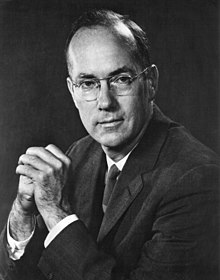
In 1953, Charles H. Townes and graduate students James P. Gordon and Herbert J. Zeiger produced the first microwave amplifier, a device operating on similar principles to the laser, but amplifying microwave radiation rather than infrared or visible radiation. Townes's maser was incapable of continuous output.[44] Meanwhile, in the Soviet Union, Nikolay Basov and Aleksandr Prokhorov were independently working on the quantum oscillator and solved the problem of continuous-output systems by using more than two energy levels. These gain media could release stimulated emissions between an excited state and a lower excited state, not the ground state, facilitating the maintenance of a population inversion. In 1955, Prokhorov and Basov suggested optical pumping of a multi-level system as a method for obtaining the population inversion, later a main method of laser pumping.
Townes reports that several eminent physicists—among them Niels Bohr, John von Neumann, and Llewellyn Thomas—argued the maser violated Heisenberg's uncertainty principle and hence could not work. Others such as Isidor Rabi and Polykarp Kusch expected that it would be impractical and not worth the effort.[45] In 1964, Charles H. Townes, Nikolay Basov, and Aleksandr Prokhorov shared the Nobel Prize in Physics, "for fundamental work in the field of quantum electronics, which has led to the construction of oscillators and amplifiers based on the maser–laser principle".
Laser
| External audio | |
|---|---|
In April 1957, Japanese engineer Jun-ichi Nishizawa proposed the concept of a "semiconductor optical maser" in a patent application.[46] That same year, Charles H. Townes and Arthur Leonard Schawlow, then at Bell Labs, began a serious study of infrared "optical masers". As ideas developed, they abandoned infrared radiation to instead concentrate on visible light.
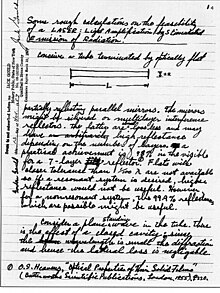
Simultaneously, Columbia University graduate student Gordon Gould was working on a doctoral thesis about the energy levels of excited thallium. Gould and Townes met and talked about radiation emission as a general subject, but not the specific work they were pursuing. Later, in November 1957, Gould noted his ideas for how a "laser" could be made, including using an open resonator (an essential laser-device component). His notebook included a diagram of an optically pumped laser. It also contained the first recorded use of the term "laser," an acronym for "light amplification by stimulated emission of radiation," along with suggestions for potential applications of the coherent light beams described.[3]
In 1958, Bell Labs filed a patent application for Schawlow and Townes's proposed optical maser; and Schawlow and Townes published a paper with their theoretical calculations in the Physical Review.[47][48][49][50][51] That same year, Prokhorov independently proposed using an open resonator, the first published appearance of this idea.
At a conference in 1959, Gordon Gould first published the acronym "LASER" in the paper The LASER, Light Amplification by Stimulated Emission of Radiation.[52][20] Gould's intention was that different "-ASER" acronyms should be used for different parts of the spectrum: "XASER" for x-rays, "UVASER" for ultraviolet, "RASER" for radio-wave, etc. Instead, the term "LASER" ended up being used for all devices operating at wavelengths shorter than microwaves.
Gould's notes included possible applications for a laser, such as optical telecommunications, spectrometry, interferometry, radar, and nuclear fusion. He continued developing the idea and filed a patent application in April 1959. The United States Patent and Trademark Office (USPTO) denied his application, and awarded a patent to Bell Labs, in 1960. That provoked a twenty-eight-year lawsuit, featuring scientific prestige and money as the stakes. Gould won his first minor patent in 1977, yet it was not until 1987 that he won the first significant patent lawsuit victory when a Federal judge ordered the USPTO to issue patents to Gould for the optically pumped and the gas discharge laser devices. The question of just how to assign credit for inventing the laser remains unresolved by historians.[53]
On May 16, 1960, Theodore H. Maiman operated the first functioning laser[54][55] at Hughes Research Laboratories, Malibu, California, ahead of several research teams, including those of Townes, at Columbia University, Arthur L. Schawlow, at Bell Labs,[56][page needed] and Gould, at the TRG (Technical Research Group) company. Maiman's functional laser used a flashlamp-pumped synthetic ruby crystal to produce red laser light at 694 nanometers wavelength. The device was only capable of pulsed operation, due to its three-level pumping design scheme. Later that year, the Iranian physicist Ali Javan, and William R. Bennett Jr., and Donald R. Herriott, constructed the first gas laser, using helium and neon that was capable of continuous operation in the infrared (U.S. Patent 3,149,290); later, Javan received the Albert Einstein World Award of Science in 1993. In 1962, Robert N. Hall demonstrated the first semiconductor laser, which was made of gallium arsenide and emitted in the near-infrared band of the spectrum at 850 nm. Later that year, Nick Holonyak Jr. demonstrated the first semiconductor laser with a visible emission. This first semiconductor laser could only be used in pulsed-beam operation, and when cooled to liquid nitrogen temperatures (77 K). In 1970, Zhores Alferov, in the USSR, and Izuo Hayashi and Morton Panish of Bell Labs also independently developed room-temperature, continual-operation diode lasers, using the heterojunction structure.
Recent innovations
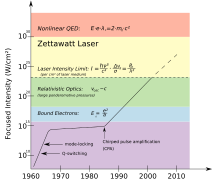
Since the early period of laser history, laser research has produced a variety of improved and specialized laser types, optimized for different performance goals, including:
- new wavelength bands
- maximum average output power
- maximum peak pulse energy
- maximum peak pulse power
- minimum output pulse duration
- minimum linewidth
- maximum power efficiency
- minimum cost
Research on improving these aspects of lasers continues to this day.
In 2015, researchers made a white laser, whose light is modulated by a synthetic nanosheet made out of zinc, cadmium, sulfur, and selenium that can emit red, green, and blue light in varying proportions, with each wavelength spanning 191 nm.[57][58][59]
In 2017, researchers at the Delft University of Technology demonstrated an AC Josephson junction microwave laser.[60] Since the laser operates in the superconducting regime, it is more stable than other semiconductor-based lasers. The device has the potential for applications in quantum computing.[61] In 2017, researchers at the Technical University of Munich demonstrated the smallest mode locking laser capable of emitting pairs of phase-locked picosecond laser pulses with a repetition frequency up to 200 GHz.[62]
In 2017, researchers from the Physikalisch-Technische Bundesanstalt (PTB), together with US researchers from JILA, a joint institute of the National Institute of Standards and Technology (NIST) and the University of Colorado Boulder, established a new world record by developing an erbium-doped fiber laser with a linewidth of only 10 millihertz.[63][64]
Types and operating principles
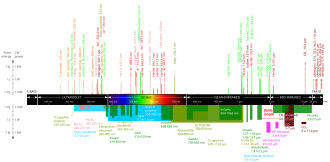
Gas lasers
Following the invention of the HeNe gas laser, many other gas discharges have been found to amplify light coherently. Gas lasers using many different gases have been built and used for many purposes. The helium–neon laser (HeNe) can operate at many different wavelengths, however, the vast majority are engineered to lase at 633 nm; these relatively low-cost but highly coherent lasers are extremely common in optical research and educational laboratories. Commercial carbon dioxide (CO2) lasers can emit many hundreds of watts in a single spatial mode which can be concentrated into a tiny spot. This emission is in the thermal infrared at 10.6 μm; such lasers are regularly used in industry for cutting and welding. The efficiency of a CO2 laser is unusually high: over 30%.[65] Argon-ion lasers can operate at several lasing transitions between 351 and 528.7 nm. Depending on the optical design one or more of these transitions can be lasing simultaneously; the most commonly used lines are 458 nm, 488 nm and 514.5 nm. A nitrogen transverse electrical discharge in gas at atmospheric pressure (TEA) laser is an inexpensive gas laser, often home-built by hobbyists, which produces rather incoherent UV light at 337.1 nm.[66] Metal ion lasers are gas lasers that generate deep ultraviolet wavelengths. Helium-silver (HeAg) 224 nm and neon-copper (NeCu) 248 nm are two examples. Like all low-pressure gas lasers, the gain media of these lasers have quite narrow oscillation linewidths, less than 3 GHz (0.5 picometers),[67] making them candidates for use in fluorescence suppressed Raman spectroscopy.
Lasing without maintaining the medium excited into a population inversion was demonstrated in 1992 in sodium gas and again in 1995 in rubidium gas by various international teams.[68][69][page needed] This was accomplished by using an external maser to induce "optical transparency" in the medium by introducing and destructively interfering the ground electron transitions between two paths so that the likelihood for the ground electrons to absorb any energy has been canceled.
Chemical lasers
Chemical lasers are powered by a chemical reaction permitting a large amount of energy to be released quickly. Such very high-power lasers are especially of interest to the military; however continuous wave chemical lasers at very high power levels, fed by streams of gasses, have been developed and have some industrial applications. As examples, in the hydrogen fluoride laser (2700–2900 nm) and the deuterium fluoride laser (3800 nm) the reaction is the combination of hydrogen or deuterium gas with combustion products of ethylene in nitrogen trifluoride.
Excimer lasers
Excimer lasers are a special sort of gas laser powered by an electric discharge in which the lasing medium is an excimer, or more precisely an exciplex in existing designs. These are molecules that can only exist with one atom in an excited electronic state. Once the molecule transfers its excitation energy to a photon, its atoms are no longer bound to each other, and the molecule disintegrates. This drastically reduces the population of the lower energy state thus greatly facilitating a population inversion. Excimers currently used are all noble gas compounds; noble gasses are chemically inert and can only form compounds while in an excited state. Excimer lasers typically operate at ultraviolet wavelengths, with major applications including semiconductor photolithography and LASIK eye surgery. Commonly used excimer molecules include ArF (emission at 193 nm), KrCl (222 nm), KrF (248 nm), XeCl (308 nm), and XeF (351 nm).[70][page needed] The molecular fluorine laser, emitting at 157 nm in the vacuum ultraviolet, is sometimes referred to as an excimer laser; however, this appears to be a misnomer since F2 is a stable compound.
Solid-state lasers
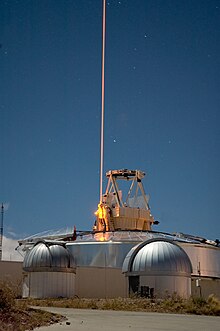
Solid-state lasers use a crystalline or glass rod that is "doped" with ions that provide the required energy states. For example, the first working laser was a ruby laser, made from ruby (chromium-doped corundum). The population inversion is maintained in the dopant. These materials are pumped optically using a shorter wavelength than the lasing wavelength, often from a flash tube or another laser. The usage of the term "solid-state" in laser physics is narrower than in typical use. Semiconductor lasers (laser diodes) are typically not referred to as solid-state lasers.
Neodymium is a common dopant in various solid-state laser crystals, including yttrium orthovanadate (Nd:YVO4), yttrium lithium fluoride (Nd:YLF) and yttrium aluminium garnet (Nd:YAG). All these lasers can produce high powers in the infrared spectrum at 1064 nm. They are used for cutting, welding, and marking of metals and other materials, and also in spectroscopy and for pumping dye lasers. These lasers are also commonly doubled, tripled or quadrupled in frequency to produce 532 nm (green, visible), 355 nm and 266 nm (UV) beams, respectively. Frequency-doubled diode-pumped solid-state (DPSS) lasers are used to make bright green laser pointers.
Ytterbium, holmium, thulium, and erbium are other common "dopants" in solid-state lasers.[71][page needed] Ytterbium is used in crystals such as Yb:YAG, Yb:KGW, Yb:KYW, Yb:SYS, Yb:BOYS, Yb:CaF2, typically operating around 1020–1050 nm. They are potentially very efficient and high-powered due to a small quantum defect. Extremely high powers in ultrashort pulses can be achieved with Yb:YAG. Holmium-doped YAG crystals emit at 2097 nm and form an efficient laser operating at infrared wavelengths strongly absorbed by water-bearing tissues. The Ho-YAG is usually operated in a pulsed mode and passed through optical fiber surgical devices to resurface joints, remove rot from teeth, vaporize cancers, and pulverize kidney and gall stones.
Titanium-doped sapphire (Ti:sapphire) produces a highly tunable infrared laser, commonly used for spectroscopy. It is also notable for use as a mode-locked laser producing ultrashort pulses of extremely high peak power.
Thermal limitations in solid-state lasers arise from unconverted pump power that heats the medium. This heat, when coupled with a high thermo-optic coefficient (dn/dT) can cause thermal lensing and reduce the quantum efficiency. Diode-pumped thin disk lasers overcome these issues by having a gain medium that is much thinner than the diameter of the pump beam. This allows for a more uniform temperature in the material. Thin disk lasers have been shown to produce beams of up to one kilowatt.[72]
Fiber lasers
Solid-state lasers or laser amplifiers where the light is guided due to the total internal reflection in a single mode optical fiber are instead called fiber lasers. Guiding of light allows extremely long gain regions, providing good cooling conditions; fibers have a high surface area to volume ratio which allows efficient cooling. In addition, the fiber's waveguiding properties tend to reduce thermal distortion of the beam. Erbium and ytterbium ions are common active species in such lasers.
Quite often, the fiber laser is designed as a double-clad fiber. This type of fiber consists of a fiber core, an inner cladding, and an outer cladding. The index of the three concentric layers is chosen so that the fiber core acts as a single-mode fiber for the laser emission while the outer cladding acts as a highly multimode core for the pump laser. This lets the pump propagate a large amount of power into and through the active inner core region while still having a high numerical aperture (NA) to have easy launching conditions.
Pump light can be used more efficiently by creating a fiber disk laser, or a stack of such lasers.
Fiber lasers, like other optical media, can suffer from the effects of photodarkening when they are exposed to radiation of certain wavelengths. In particular, this can lead to degradation of the material and loss in laser functionality over time. The exact causes and effects of this phenomenon vary from material to material, although it often involves the formation of color centers.[73]
Photonic crystal lasers
Photonic crystal lasers are lasers based on nano-structures that provide the mode confinement and the density of optical states (DOS) structure required for the feedback to take place.[clarification needed] They are typical micrometer-sized[dubious – discuss] and tunable on the bands of the photonic crystals.[74][clarification needed]
Semiconductor lasers
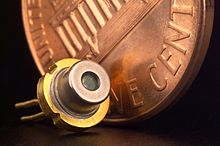
Semiconductor lasers are diodes that are electrically pumped. Recombination of electrons and holes created by the applied current introduces optical gain. Reflection from the ends of the crystal forms an optical resonator, although the resonator can be external to the semiconductor in some designs.
Commercial laser diodes emit at wavelengths from 375 nm to 3500 nm.[75] Low to medium power laser diodes are used in laser pointers, laser printers and CD/DVD players. Laser diodes are also frequently used to optically pump other lasers with high efficiency. The highest-power industrial laser diodes, with power of up to 20 kW, are used in industry for cutting and welding.[76] External-cavity semiconductor lasers have a semiconductor active medium in a larger cavity. These devices can generate high power outputs with good beam quality, wavelength-tunable narrow-linewidth radiation, or ultrashort laser pulses.
In 2012, Nichia and OSRAM developed and manufactured commercial high-power green laser diodes (515/520 nm), which compete with traditional diode-pumped solid-state lasers.[77][78]
Vertical cavity surface-emitting lasers (VCSELs) are semiconductor lasers whose emission direction is perpendicular to the surface of the wafer. VCSEL devices typically have a more circular output beam than conventional laser diodes. As of 2005, only 850 nm VCSELs are widely available, with 1300 nm VCSELs beginning to be commercialized[79] and 1550 nm devices being an area of research. VECSELs are external-cavity VCSELs. Quantum cascade lasers are semiconductor lasers that have an active transition between energy sub-bands of an electron in a structure containing several quantum wells.
The development of a silicon laser is important in the field of optical computing. Silicon is the material of choice for integrated circuits, and so electronic and silicon photonic components (such as optical interconnects) could be fabricated on the same chip. Unfortunately, silicon is a difficult lasing material to deal with, since it has certain properties which block lasing. However, recently teams have produced silicon lasers through methods such as fabricating the lasing material from silicon and other semiconductor materials, such as indium(III) phosphide or gallium(III) arsenide, materials that allow coherent light to be produced from silicon. These are called hybrid silicon lasers. Recent developments have also shown the use of monolithically integrated nanowire lasers directly on silicon for optical interconnects, paving the way for chip-level applications.[80] These heterostructure nanowire lasers capable of optical interconnects in silicon are also capable of emitting pairs of phase-locked picosecond pulses with a repetition frequency up to 200 GHz, allowing for on-chip optical signal processing.[62] Another type is a Raman laser, which takes advantage of Raman scattering to produce a laser from materials such as silicon.
Dye lasers

Dye lasers use an organic dye as the gain medium. The wide gain spectrum of available dyes, or mixtures of dyes, allows these lasers to be highly tunable, or to produce very short-duration pulses (on the order of a few femtoseconds). Although these tunable lasers are mainly known in their liquid form, researchers have also demonstrated narrow-linewidth tunable emission in dispersive oscillator configurations incorporating solid-state dye gain media. In their most prevalent form, these solid-state dye lasers use dye-doped polymers as laser media.
Bubble lasers are dye lasers that use a bubble as the optical resonator. Whispering gallery modes in the bubble produce an output spectrum composed of hundreds of evenly spaced peaks: a frequency comb. The spacing of the whispering gallery modes is directly related to the bubble circumference, allowing bubble lasers to be used as highly sensitive pressure sensors.[81]
Free-electron lasers

Free-electron lasers (FEL) generate coherent, high-power radiation that is widely tunable, currently ranging in wavelength from microwaves through terahertz radiation and infrared to the visible spectrum, to soft X-rays. They have the widest frequency range of any laser type. While FEL beams share the same optical traits as other lasers, such as coherent radiation, FEL operation is quite different. Unlike gas, liquid, or solid-state lasers, which rely on bound atomic or molecular states, FELs use a relativistic electron beam as the lasing medium, hence the term free-electron.
Exotic media
The pursuit of a high-quantum-energy laser using transitions between isomeric states of an atomic nucleus has been the subject of wide-ranging academic research since the early 1970s. Much of this is summarized in three review articles.[82][83][84] This research has been international in scope but mainly based in the former Soviet Union and the United States. While many scientists remain optimistic that a breakthrough is near, an operational gamma-ray laser is yet to be realized.[85]
Some of the early studies were directed toward short pulses of neutrons exciting the upper isomer state in a solid so the gamma-ray transition could benefit from the line-narrowing of Mössbauer effect.[86][page needed][87] In conjunction, several advantages were expected from two-stage pumping of a three-level system.[88] It was conjectured that the nucleus of an atom embedded in the near field of a laser-driven coherently-oscillating electron cloud would experience a larger dipole field than that of the driving laser.[89][90] Furthermore, the nonlinearity of the oscillating cloud would produce both spatial and temporal harmonics, so nuclear transitions of higher multipolarity could also be driven at multiples of the laser frequency.[91][92][93][94][95][96][97]
In September 2007, the BBC News reported that there was speculation about the possibility of using positronium annihilation to drive a very powerful gamma ray laser.[98] David Cassidy of the University of California, Riverside proposed that a single such laser could be used to ignite a nuclear fusion reaction, replacing the banks of hundreds of lasers currently employed in inertial confinement fusion experiments.[98]
Space-based X-ray lasers pumped by nuclear explosions have also been proposed as antimissile weapons.[99][100] Such devices would be one-shot weapons.
Living cells have been used to produce laser light.[101][102] The cells were genetically engineered to produce green fluorescent protein, which served as the laser's gain medium. The cells were then placed between two 20-micrometer-wide mirrors, which acted as the laser cavity. When the cell was illuminated with blue light, it emitted intensely directed green laser light.
Natural lasers
Like astrophysical masers, irradiated planetary or stellar gases may amplify light producing a natural laser.[103] Mars,[104] Venus, and MWC 349 exhibit this phenomenon.
Uses
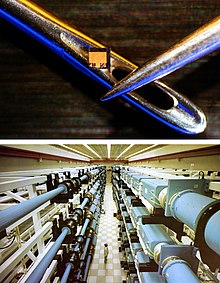
When the laser was first invented, it was called "a solution looking for a problem",[105] although Gould noted numerous possible applications in his notebook and patent applications.[106][107] Since then, they have become ubiquitous, finding utility in thousands of highly varied applications in every section of modern society, including consumer electronics, information technology, science, medicine, industry, law enforcement, entertainment, and the military. Fiber-optic communication relies on multiplexed lasers in dense wave-division multiplexing (WDM) systems to transmit large amounts of data over long distances.[108][109][110]
The first widely noticeable use of lasers was the supermarket barcode scanner, introduced in 1974. The laserdisc player, introduced in 1978, was the first successful consumer product to include a laser, but the compact disc player was the first laser-equipped device to become common, commercialized in 1982, followed shortly by laser printers.
Some other uses are:
- Communications: besides fiber-optic communication, lasers are used for free-space optical communication, including laser communication in space
- Medicine: see below
- Industry: cutting including converting thin materials, welding, material heat treatment, marking parts (engraving and bonding), additive manufacturing or 3D printing processes such as selective laser sintering and selective laser melting, laser metal deposition, and non-contact measurement of parts and 3D scanning, and laser cleaning.
- Military: marking targets, guiding munitions, missile defense, electro-optical countermeasures (EOCM), lidar, blinding troops, firearms sights. See below
- Law enforcement: LIDAR traffic enforcement. Lasers are used for latent fingerprint detection in the forensic identification field[111][112]
- Research: spectroscopy, laser ablation, laser annealing, laser scattering, laser interferometry, lidar, laser capture microdissection, fluorescence microscopy, metrology, laser cooling
- Commercial products: laser printers, barcode scanners, thermometers, laser pointers, holograms, bubblegrams
- Entertainment: optical discs, laser lighting displays, laser turntables.
- Informational markings: Laser lighting display technology can be used to project informational markings onto surfaces such as playing fields, roads, runways, or warehouse floors.[113][114][115]
In 2004, excluding diode lasers, approximately 131,000 lasers were sold ,with a value of US$2.19 billion.[116] In the same year, approximately 733 million diode lasers, valued at US$3.20 billion, were sold.[117] Global Industrial laser sales in 2023 reached $21.85 billion.
In medicine
Lasers have many uses in medicine, including laser surgery (particularly eye surgery), laser healing (photobiomodulation therapy), kidney stone treatment, ophthalmoscopy, and cosmetic skin treatments such as acne treatment, cellulite and striae reduction, and hair removal.
Lasers are used to treat cancer by shrinking or destroying tumors or precancerous growths. They are most commonly used to treat superficial cancers that are on the surface of the body or the lining of internal organs. They are used to treat basal cell skin cancer and the very early stages of others like cervical, penile, vaginal, vulvar, and non-small cell lung cancer. Laser therapy is often combined with other treatments, such as surgery, chemotherapy, or radiation therapy. Laser-induced interstitial thermotherapy (LITT), or interstitial laser photocoagulation, uses lasers to treat some cancers using hyperthermia, which uses heat to shrink tumors by damaging or killing cancer cells. Lasers are more precise than traditional surgery methods and cause less damage, pain, bleeding, swelling, and scarring. A disadvantage is that surgeons must acquire specialized training, and thus it will likely be more expensive than other treatments.[118][119]
As weapons
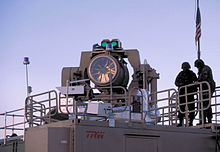
A laser weapon is a type of directed-energy weapon that uses lasers to inflict damage.[120] Whether they will be deployed as practical, high-performance military weapons remains to be seen.[121][122] One of the major issues with laser weapons is atmospheric thermal blooming, which is still largely unsolved. This issue is exacerbated when there is fog, smoke, dust, rain, snow, smog, foam, or purposely dispersed obscurant chemicals present. The United States Navy has tested the very short range (1 mile), 30-kW Laser Weapon System or LaWS to be used against targets like small UAVs, rocket-propelled grenades, and visible motorboat or helicopter engines.[123][124] It has been described as "six welding lasers strapped together." A 60 kW system, HELIOS, is being developed for destroyer-class ships as of 2020[update].[125] [126]

Lasers can be used as incapacitating non-lethal weapons.[citation needed] They can cause temporary or permanent vision loss when directed at the eyes. Even lasers with a power output of less than one watt can cause immediate and permanent vision loss under certain conditions, making them potentially non-lethal but incapacitating weapons. The use of such lasers is morally controversial due to the extreme handicap that laser-induced blindness represents. The Protocol on Blinding Laser Weapons bans the use of weapons designed to cause permanent blindness. Weapons designed to cause temporary blindness, known as dazzlers, are used by military and sometimes law enforcement organizations.
Hobbies
In recent years, some hobbyists have taken an interest in lasers. Lasers used by hobbyists are generally of class IIIa or IIIb , although some have made their own class IV types.[127] However, due to the cost and potential dangers, this is an uncommon hobby. Some hobbyists salvage laser diodes from broken DVD players (red), Blu-ray players (violet), or even higher power laser diodes from CD or DVD burners.[128]
Hobbyists have also used surplus lasers taken from retired military applications and modified them for holography. Pulsed ruby and YAG lasers work well for this application.
Examples by power
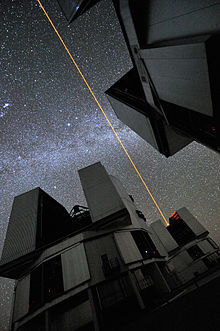
Different applications need lasers with different output powers. Lasers that produce a continuous beam or a series of short pulses can be compared on the basis of their average power. Lasers that produce pulses can also be characterized based on the peak power of each pulse. The peak power of a pulsed laser is many orders of magnitude greater than its average power. The average output power is always less than the power consumed.
| Power | Use |
|---|---|
| 1–5 mW | Laser pointers |
| 5 mW | CD-ROM drive |
| 5–10 mW | DVD player or DVD-ROM drive |
| 100 mW | High-speed CD-RW burner |
| 250 mW | Consumer 16× DVD-R burner |
| 400 mW | DVD 24× dual-layer recording[129] |
| 1 W | Green laser in Holographic Versatile Disc prototype development |
| 1–20 W | Output of the majority of commercially available solid-state lasers used for micro machining |
| 30–100 W | Typical sealed CO2 surgical lasers[130] |
| 100–3000 W | Typical sealed CO2 lasers used in industrial laser cutting |
Examples of pulsed systems with high peak power:
- 700 TW (700×1012 W)—National Ignition Facility, a 192-beam, 1.8-megajoule laser system adjoining a 10-meter-diameter target chamber[131]
- 10 PW (10×1015 W)—world's most powerful laser as of 2019, located at the ELI-NP facility in Măgurele, Romania.[132]
Safety
Even the first laser was recognized as being potentially dangerous. Theodore Maiman characterized the first laser as having the power of one "Gillette", as it could burn through one Gillette razor blade.[133][134] Today, it is accepted that even low-power lasers with only a few milliwatts of output power can be hazardous to human eyesight when the beam hits the eye directly or after reflection from a shiny surface. At wavelengths which the cornea and the lens can focus well, the coherence and low divergence of laser light means that it can be focused by the eye into an extremely small spot on the retina, resulting in localized burning and permanent damage in seconds or even less time.
Lasers are usually labeled with a safety class number, which identifies how dangerous the laser is:
- Class 1 is inherently safe, usually because the light is contained in an enclosure, for example in CD players
- Class 2 is safe during normal use; the blink reflex of the eye will prevent damage. Usually up to 1 mW power, for example, laser pointers.
- Class 3R (formerly IIIa) lasers are usually up to 5 mW and involve a small risk of eye damage within the time of the blink reflex. Staring into such a beam for several seconds is likely to cause damage to a spot on the retina.
- Class 3B lasers (5–499 mW) can cause immediate eye damage upon exposure.
- Class 4 lasers (≥ 500 mW) can burn skin, and in some cases, even scattered light from these lasers can cause eye and/or skin damage. Many industrial and scientific lasers are in this class.
The indicated powers are for visible-light, continuous-wave lasers. For pulsed lasers and invisible wavelengths, other power limits apply. People working with class 3B and class 4 lasers can protect their eyes with safety goggles which are designed to absorb light of a particular wavelength.
Infrared lasers with wavelengths longer than about 1.4 micrometers are often referred to as "eye-safe", because the cornea tends to absorb light at these wavelengths, protecting the retina from damage. The label "eye-safe" can be misleading, however, as it applies only to relatively low-power continuous wave beams; a high-power or Q-switched laser at these wavelengths can burn the cornea, causing severe eye damage, and even moderate-power lasers can injure the eye.
Lasers can be a hazard to both civil and military aviation, due to the potential to temporarily distract or blind pilots. See Lasers and aviation safety for more on this topic.
Cameras based on charge-coupled devices may be more sensitive to laser damage than biological eyes.[135]
See also
References
- ^ Taylor, Nick (2000). Laser: The Inventor, The Nobel Laureate, and The Thirty-Year Patent War. Simon & Schuster. p. 66. ISBN 978-0684835150.
- ^ Ross T., Adam; Becker G., Daniel (2001). Proceedings of Laser Surgery: Advanced Characterization, Therapeutics, and Systems. SPIE. p. 396. ISBN 978-0-8194-3922-2.
- ^ a b Taylor N (2022). "The Invention of the Laser". Optical Tweezers. Methods Mol Biol. Vol. 2478. pp. 3–10. doi:10.1007/978-1-0716-2229-2_1. ISBN 978-1-0716-2228-5. PMID 36063315.
- ^ Independent, The (September 23, 2005). "Gordon Gould". The Independent. Retrieved January 10, 2025.
- ^ "December 1958: Invention of the Laser". aps.org. Archived from the original on December 10, 2021. Retrieved January 27, 2022.
- ^ Ning, Jinna; Zhang, Wenrui; Cao, Changqing; Feng, Zhejun; Zeng, Xiaodong; Wang, Ting; Wang, Rui; Song, Qi; Fan, Shuanglin (2019). "Collimation of laser diode beams for free space optical communications". Infrared Physics & Technology. 102. Elsevier BV: 102996. Bibcode:2019InPhT.10202996N. doi:10.1016/j.infrared.2019.102996. ISSN 1350-4495.
- ^ Castelvecchi, Davide; Sanderson, Katharine (October 3, 2023). "Physicists who built ultrafast 'attosecond' lasers win Nobel Prize". Nature. 622 (7982): 225–227. Bibcode:2023Natur.622..225C. doi:10.1038/d41586-023-03047-w. PMID 37789199. Retrieved November 14, 2024.
- ^ Prisco, Jacopo (October 9, 2024). "Lasers could take broadband where fiber optics can't". CNN. Retrieved January 10, 2025.
- ^ Trainer, Matthew (2010). "The 50th anniversary of the laser". World Patent Information. 32 (4): 326–330. doi:10.1016/j.wpi.2010.06.005.
- ^ Saleh, Bahaa (2016), Al-Amri, Mohammad D.; El-Gomati, Mohamed; Zubairy, M. Suhail (eds.), "The Laser", Optics in Our Time, Cham: Springer International Publishing, pp. 71–85, doi:10.1007/978-3-319-31903-2_4, ISBN 978-3-319-31902-5
- ^ Heilbron, John L. (March 27, 2003). The Oxford Companion to the History of Modern Science. Oxford University Press. pp. 447. ISBN 978-0-19-974376-6.
- ^ Bertolotti, Mario (October 1, 2004). The History of the Laser. CRC Press. pp. 215, 218–219. ISBN 978-1-4200-3340-3.
- ^ Hall, Carla (December 17, 1987). "Inventor Beams Over Laser Patents : After 30 Years, Gordon Gould Gets Credit He Deserves". Los Angeles Times. Retrieved November 1, 2024.
- ^ II, Thomas H. Maugh (September 21, 2005). "Gordon Gould, 85; Physicist Finally Got His Due for the Laser". Los Angeles Times. Retrieved November 1, 2024.
- ^ McAulay, Alastair D. (May 31, 2011). Military Laser Technology for Defense: Technology for Revolutionizing 21st Century Warfare. John Wiley & Sons. p. 127. ISBN 978-0-470-25560-5.
- ^ Renk, Karl F. (February 9, 2012). Basics of Laser Physics: For Students of Science and Engineering. Springer Science & Business Media. p. 4. ISBN 978-3-642-23565-8.
- ^ "LASE". Collins Dictionary. Retrieved January 6, 2024.
- ^ "LASING". Collins Dictionary. Retrieved January 6, 2024.
- ^ Strelnitski, Vladimir (1997). "Masers, Lasers and the Interstellar Medium". Astrophysics and Space Science. 252 (1–2): 279–287. Bibcode:1997Ap&SS.252..279S. doi:10.1023/A:1000892300429. S2CID 115181195.
- ^ a b c Chu, Steven; Townes, Charles (2003). "Arthur Schawlow". In Edward P. Lazear (ed.). Biographical Memoirs. Vol. 83. National Academy of Sciences. p. 202. ISBN 978-0-309-08699-8.
- ^ Al-Amri, Mohammad D.; El-Gomati, Mohamed; Zubairy, M. Suhail (December 12, 2016). Optics in Our Time. Springer. p. 76. ISBN 978-3-319-31903-2.
- ^ Hecht, Jeff (December 27, 2018). Understanding Lasers: An Entry-Level Guide. John Wiley & Sons. p. 201. ISBN 978-1-119-31064-8.
- ^ "UCSB Science Line". scienceline.ucsb.edu. Retrieved December 9, 2024.
- ^ Feldmann, Sascha (August 2, 2023). "Taming the tiniest of lasers: Electrically pumped amplified spontaneous emission from nanocrystals". Matter. 6 (8): 2568–2570. doi:10.1016/j.matt.2023.06.022. ISSN 2590-2393.
- ^ "anacronym". Wordsmith.org. Retrieved December 9, 2024.
- ^ a b Hecht, Eugene (1998). Optics (3 ed.). Reading, Mass: Addison-Wesley. ISBN 978-0-201-83887-9.
- ^ Conceptual physics, Paul Hewitt, 2002
- ^ Siegman, Anthony E. (1986). Lasers. University Science Books. p. 2. ISBN 978-0-935702-11-8.
- ^ Pearsall 2020, p. 276=285.
- ^ Pearsall, Thomas (2010). Photonics Essentials, 2nd edition. McGraw-Hill. ISBN 978-0-07-162935-5. Archived from the original on August 17, 2021. Retrieved February 23, 2021.
- ^ Siegman, Anthony E. (1986). Lasers. University Science Books. p. 4. ISBN 978-0-935702-11-8.
- ^ Walker, Jearl (June 1974). "Nitrogen Laser". Light and Its Uses. W. H. Freeman. pp. 40–43. ISBN 978-0-7167-1185-8.
{{cite book}}:|work=ignored (help) - ^ Pollnau, M. (2018). "Phase aspect in photon emission and absorption" (PDF). Optica. 5 (4): 465–474. Bibcode:2018Optic...5..465P. doi:10.1364/OPTICA.5.000465. Archived from the original on February 8, 2023. Retrieved June 28, 2020.
- ^ Pollnau, M.; Eichhorn, M. (2020). "Spectral coherence, Part I: Passive resonator linewidth, fundamental laser linewidth, and Schawlow-Townes approximation". Progress in Quantum Electronics. 72: 100255. Bibcode:2020PQE....7200255P. doi:10.1016/j.pquantelec.2020.100255.
- ^ Glauber, R.J. (1963). "Coherent and incoherent states of the radiation field" (PDF). Phys. Rev. 131 (6): 2766–2788. Bibcode:1963PhRv..131.2766G. doi:10.1103/PhysRev.131.2766. Archived (PDF) from the original on May 8, 2021. Retrieved February 23, 2021.
- ^ Pearsall 2020, p. 276.
- ^ Karman, G.P.; McDonald, G.S.; New, G.H.C.; Woerdman, J.P. (November 1999). "Laser Optics: Fractal modes in unstable resonators". Nature. 402 (6758): 138. Bibcode:1999Natur.402..138K. doi:10.1038/45960. S2CID 205046813.
- ^ Einstein, A (1917). "Zur Quantentheorie der Strahlung". Physikalische Zeitschrift. 18: 121–128. Bibcode:1917PhyZ...18..121E.
- ^ a b Steen, W.M. "Laser Materials Processing", 2nd Ed. 1998.
- ^ Batani, Dimitri (2004). "Il rischio da laser: cosa è e come affrontarlo; analisi di un problema non così lontano da noi" [The risk from laser: what it is and what it is like facing it; analysis of a problem which is thus not far away from us]. wwwold.unimib.it. Programma Corso di Formazione Obbligatorio (in Italian). University of Milano-Bicocca. p. 12. Archived from the original (Powerpoint) on June 14, 2007. Retrieved January 1, 2007.
- ^ The Nobel Prize in Physics 1966 Archived June 4, 2011, at the Wayback Machine Presentation Speech by Professor Ivar Waller. Retrieved January 1, 2007.
- ^ "American Institute of Physics Oral History Interview with Joseph Weber". May 4, 2015. Archived from the original on March 8, 2016. Retrieved March 16, 2016.
- ^ Bertolotti, Mario (2015). Masers and Lasers: An Historical Approach (2nd ed.). CRC Press. pp. 89–91. ISBN 978-1-4822-1780-3. Retrieved March 15, 2016.
- ^ "Guide to Lasers". Hobarts. Archived from the original on April 24, 2019. Retrieved April 24, 2017.
- ^ Townes, Charles H. (1999). How the Laser Happened: Adventures of a Scientist, Oxford University Press, ISBN 978-0-19-512268-8, pp. 69–70.
- ^ Nishizawa, Jun-ichi (December 2009). "Extension of frequencies from maser to laser". Proc Jpn Acad Ser B Phys Biol Sci. 85 (10): 454–465. Bibcode:2009PJAB...85..454N. doi:10.2183/pjab.85.454. PMC 3621550. PMID 20009378.
- ^ Schawlow, Arthur; Townes, Charles (1958). "Infrared and Optical Masers". Physical Review. 112 (6): 1940–1949. Bibcode:1958PhRv..112.1940S. doi:10.1103/PhysRev.112.1940.
- ^ "Invention of the LASER". Invention & Technology Magazine. Retrieved November 1, 2024.
- ^ "Bell Labs". Invention & Technology Magazine. Retrieved November 1, 2024.
- ^ "The Back Page". American Physical Society. May 4, 2005. Retrieved November 1, 2024.
- ^ "The Laser Turns 50 (images)". CBS News. May 15, 2010. Retrieved November 1, 2024.
- ^ Gould, R. Gordon (1959). "The LASER, Light Amplification by Stimulated Emission of Radiation". In Franken, P.A.; Sands R.H. (eds.). The Ann Arbor Conference on Optical Pumping, the University of Michigan, 15 June through 18 June 1959. p. 128. OCLC 02460155.
- ^ Joan Lisa Bromberg, The Laser in America, 1950–1970 (1991), pp. 74–77 online Archived May 28, 2014, at the Wayback Machine
- ^ Maiman, T. H. (1960). "Stimulated optical radiation in ruby". Nature. 187 (4736): 493–494. Bibcode:1960Natur.187..493M. doi:10.1038/187493a0. S2CID 4224209.
- ^ Townes, Charles Hard. "The first laser". University of Chicago. Archived from the original on April 4, 2004. Retrieved May 15, 2008.
- ^ Hecht, Jeff (2005). Beam: The Race to Make the Laser. Oxford University Press. ISBN 978-0-19-514210-5.
- ^ "For The First Time, A Laser That Shines Pure White". Popular Science. March 18, 2019. Archived from the original on December 16, 2019. Retrieved December 16, 2019.
- ^ "Researchers demonstrate the world's first white lasers". phys.org. Archived from the original on December 16, 2019. Retrieved December 16, 2019.
- ^ "Scientists Finally Created a White Laser—and It Could Light Your Home". gizmodo.com. July 30, 2015. Archived from the original on December 16, 2019. Retrieved December 16, 2019.
- ^ "Researchers demonstrate new type of laser". Phys.org. Archived from the original on March 3, 2017. Retrieved March 4, 2017.
- ^ Cassidy, M. C.; Bruno, A.; Rubbert, S.; Irfan, M.; Kammhuber, J.; Schouten, R.N.; Akhmerov, A.R.; Kouwenhoven, L.P. (March 2, 2017). "Demonstration of an ac Josephson junction laser". Science. 355 (6328): 939–942. arXiv:1703.05404. Bibcode:2017Sci...355..939C. doi:10.1126/science.aah6640. PMID 28254938. S2CID 1364541.
- ^ a b Mayer, B.; Regler, A.; Sterzl, S.; Stettner, T.; Koblmüller, G.; Kaniber, M.; Lingnau, B.; Lüdge, K.; Finley, J.J. (May 23, 2017). "Long-term mutual phase locking of picosecond pulse pairs generated by a semiconductor nanowire laser". Nature Communications. 8: 15521. arXiv:1603.02169. Bibcode:2017NatCo...815521M. doi:10.1038/ncomms15521. PMC 5457509. PMID 28534489.
- ^ Erika Schow (June 29, 2017). "The Physikalisch-Technische Bundesanstalt has developed a laser with a linewidth of only 10 mHz" (Press release). Archived from the original on July 3, 2017.
- ^ Matei, D.G.; Legero, T.; Häfner, S.; et al. (June 30, 2017). "1.5 μm Lasers with Sub-10 mHz Linewidth". Phys. Rev. Lett. 118 (26): 263202. arXiv:1702.04669. Bibcode:2017PhRvL.118z3202M. doi:10.1103/PhysRevLett.118.263202. PMID 28707932. S2CID 206293342.
- ^ Nolen, Jim; Derek Verno. "The Carbon Dioxide Laser". Davidson Physics. Archived from the original on October 11, 2014. Retrieved August 17, 2014.
- ^ Csele, Mark (2004). "The TEA Nitrogen Gas Laser". Homebuilt Lasers Page. Archived from the original on September 11, 2007. Retrieved September 15, 2007.
- ^ "Deep UV Lasers" (PDF). Photon Systems, Covina, Calif. Archived from the original (PDF) on July 1, 2007. Retrieved May 27, 2007.
- ^ Mompart, J.; Corbalán, R. (2000). "Lasing without inversion". J. Opt. B. 2 (3): R7 – R24. Bibcode:2000JOptB...2R...7M. doi:10.1088/1464-4266/2/3/201. S2CID 121209763.
- ^ Javan, A. (2000). "On knowing Marlan". Ode to a quantum physicist: A festschrift in honor of Marlan O. Scully. Elsevier.
- ^ Schuocker, D. (1998). Handbook of the Eurolaser Academy. Springer. ISBN 978-0-412-81910-0.
- ^ Bass, Michael; DeCusatis, Casimer; Enoch, Jay; Lakshminarayanan, Vasudevan; Li, Guifang; MacDonald, Carolyn; Mahajan, Virendra; Stryland, Eric Van (November 13, 2009). Handbook of Optics, Third Edition Volume V: Atmospheric Optics, Modulators, Fiber Optics, X-Ray and Neutron Optics. McGraw Hill Professional. ISBN 978-0-07-163314-7. Archived from the original on February 8, 2023. Retrieved July 16, 2017.
- ^ C. Stewen, M. Larionov, and A. Giesen, "Yb:YAG thin disk laser with 1 kW output power", in OSA Trends in Optics and Photonics, Advanced Solid-State Lasers, H. Injeyan, U. Keller, and C. Marshall, ed. (Optical Society of America, Washington, D.C., 2000) pp. 35–41.
- ^ Paschotta, Rüdiger. "Photodarkening". www.rp-photonics.com. Archived from the original on June 25, 2023. Retrieved July 22, 2023.
- ^ Wu, X.; et al. (October 25, 2004). "Ultraviolet photonic crystal laser". Applied Physics Letters. 85 (17): 3657. arXiv:physics/0406005. Bibcode:2004ApPhL..85.3657W. doi:10.1063/1.1808888. S2CID 119460787.
- ^ "Laser Diode Market". Hanel Photonics. Archived from the original on December 7, 2015. Retrieved September 26, 2014.
- ^ "High-power direct-diode lasers for cutting and welding". industrial-lasers.com. Archived from the original on August 11, 2018. Retrieved August 11, 2018.
- ^ "LASER Diode". nichia.co.jp. Archived from the original on March 18, 2014. Retrieved March 18, 2014.
- ^ "Green Laser". osram-os.com. August 19, 2015. Archived from the original on March 18, 2014. Retrieved March 18, 2014.
- ^ "Picolight ships first 4-Gbit/s 1310-nm VCSEL transceivers". Laser Focus World Online. December 9, 2005. Archived from the original on March 13, 2006. Retrieved May 27, 2006.
- ^ Mayer, B.; Janker, L.; Loitsch, B.; Treu, J.; Kostenbader, T.; Lichtmannecker, S.; Reichert, T.; Morkötter, S.; Kaniber, M.; Abstreiter, G.; Gies, C.; Koblmüller, G.; Finley, J.J. (January 13, 2016). "Monolithically Integrated High-β Nanowire Lasers on Silicon". Nano Letters. 16 (1): 152–156. Bibcode:2016NanoL..16..152M. doi:10.1021/acs.nanolett.5b03404. PMID 26618638.
- ^ Miller, Johanna (2024). "Bubble lasers can be sturdy and sensitive". Physics Today. 77 (3). American Institute of Physics: 12–14. Bibcode:2024PhT....77c..12M. doi:10.1063/pt.xafv.lnix.
- ^ Baldwin, G.C.; Solem, J.C.; Gol'danskii, V. I. (1981). "Approaches to the development of gamma-ray lasers". Reviews of Modern Physics. 53 (4): 687–744. Bibcode:1981RvMP...53..687B. doi:10.1103/RevModPhys.53.687.
- ^ Baldwin, G.C.; Solem, J.C. (1995). "Recent proposals for gamma-ray lasers". Laser Physics. 5 (2): 231–239.
- ^ Baldwin, G.C.; Solem, J.C. (1997). "Recoilless gamma-ray lasers". Reviews of Modern Physics. 69 (4): 1085–1117. Bibcode:1997RvMP...69.1085B. doi:10.1103/RevModPhys.69.1085. Archived from the original on July 28, 2019. Retrieved June 13, 2019.
- ^ Baldwin, G.C.; Solem, J.C. (1982). "Is the time ripe? Or must we wait so long for breakthroughs?". Laser Focus. 18 (6): 6&8.
- ^ Solem, J.C. (1979). "On the feasibility of an impulsively driven gamma-ray laser". Los Alamos Scientific Laboratory Report LA-7898. doi:10.2172/6010532. OSTI 6010532.
- ^ Baldwin, G.C.; Solem, J.C. (1979). "Maximum density and capture rates of neutrons moderated from a pulsed source". Nuclear Science & Engineering. 72 (3): 281–289. Bibcode:1979NSE....72..281B. doi:10.13182/NSE79-A20384. Archived from the original on February 7, 2016. Retrieved January 13, 2016.
- ^ Baldwin, G.C.; Solem, J.C. (1980). "Two-stage pumping of three-level Mössbauer gamma-ray lasers". Journal of Applied Physics. 51 (5): 2372–2380. Bibcode:1980JAP....51.2372B. doi:10.1063/1.328007.
- ^ Solem, J.C. (1986). "Interlevel transfer mechanisms and their application to grasers". AIP Conference Proceedings. Proceedings of Advances in Laser Science-I, First International Laser Science Conference, Dallas, TX 1985 (American Institute of Physics, Optical Science and Engineering, Series 6). Vol. 146. pp. 22–25. Bibcode:1986AIPC..146...22S. doi:10.1063/1.35861. Archived from the original on November 27, 2018. Retrieved November 27, 2018.
- ^ Biedenharn, L.C.; Boyer, K.; Solem, J.C. (1986). "Possibility of grasing by laser-driven nuclear excitation". AIP Conference Proceedings. Proceedings of AIP Advances in Laser Science-I, Dallas, TX, November 18–22, 1985. Vol. 146. pp. 50–51. Bibcode:1986AIPC..146...50B. doi:10.1063/1.35928.
- ^ Rinker, G.A.; Solem, J.C.; Biedenharn, L.C. (April 27, 1988). "Calculation of harmonic radiation and nuclear coupling arising from atoms in strong laser fields". In Jones, Randy C (ed.). Proc. SPIE 0875, Short and Ultrashort Wavelength Lasers. 1988 Los Angeles Symposium: O-E/LASE '88, 1988, Los Angeles, CA, United States. Short and Ultrashort Wavelength Lasers. Vol. 146. International Society for Optics and Photonics. pp. 92–101. doi:10.1117/12.943887.
- ^ Rinker, G. A.; Solem, J.C.; Biedenharn, L.C. (1987). Lapp, M.; Stwalley, W.C.; Kenney-Wallace G.A. (eds.). "Nuclear interlevel transfer driven by collective outer shell electron excitations". Proceedings of the Second International Laser Science Conference, Seattle, WA (Advances in Laser Science-II). 160. New York: American Institute of Physics: 75–86. OCLC 16971600.
- ^ Solem, J.C. (1988). "Theorem relating spatial and temporal harmonics for nuclear interlevel transfer driven by collective electronic oscillation". Journal of Quantitative Spectroscopy and Radiative Transfer. 40 (6): 713–715. Bibcode:1988JQSRT..40..713S. doi:10.1016/0022-4073(88)90067-2. Archived from the original on March 18, 2020. Retrieved September 8, 2019.
- ^ Solem, J.C.; Biedenharn, L.C. (1987). "Primer on coupling collective electronic oscillations to nuclei" (PDF). Los Alamos National Laboratory Report LA-10878: 1. Bibcode:1987pcce.rept.....S. Archived (PDF) from the original on March 4, 2016. Retrieved January 13, 2016.
- ^ Solem, J.C.; Biedenharn, L.C. (1988). "Laser coupling to nuclei via collective electronic oscillations: A simple heuristic model study". Journal of Quantitative Spectroscopy and Radiative Transfer. 40 (6): 707–712. Bibcode:1988JQSRT..40..707S. doi:10.1016/0022-4073(88)90066-0.
- ^ Boyer, K.; Java, H.; Luk, T.S.; McIntyre, I.A.; McPherson, A.; Rosman, R.; Solem, J.C.; Rhodes, C.K.; Szöke, A. (1987). "Discussion of the role of many-electron motions in multiphoton ionization and excitation". In Smith, S.; Knight, P. (eds.). Proceedings of International Conference on Multiphoton Processes (ICOMP) IV, July 13–17, 1987, Boulder, CA. Cambridge, England: Cambridge University Press. p. 58. OSTI 10147730.
- ^ Biedenharn, L.C.; Rinker, G.A.; Solem, J.C. (1989). "A solvable approximate model for the response of atoms subjected to strong oscillatory electric fields". Journal of the Optical Society of America B. 6 (2): 221–227. Bibcode:1989JOSAB...6..221B. doi:10.1364/JOSAB.6.000221. Archived from the original on March 21, 2020. Retrieved June 13, 2019.
- ^ a b Fildes, Jonathan (September 12, 2007). "Mirror particles form new matter". BBC News. Archived from the original on April 21, 2009. Retrieved May 22, 2008.
- ^ Hecht, Jeff (May 2008). "The history of the x-ray laser". Optics and Photonics News. 19 (5): 26–33. Bibcode:2008OptPN..19R..26H. doi:10.1364/opn.19.5.000026.
- ^ Robinson, Clarence A. (February 23, 1981). "Advance made on high-energy laser". Aviation Week & Space Technology. pp. 25–27.
- ^ Palmer, Jason (June 13, 2011). "Laser is produced by a living cell". BBC News. Archived from the original on June 13, 2011. Retrieved June 13, 2011.
- ^ Malte C. Gather & Seok Hyun Yun (June 12, 2011). "Single-cell biological lasers". Nature Photonics. 5 (7): 406–410. Bibcode:2011NaPho...5..406G. doi:10.1038/nphoton.2011.99.
- ^ Chen, Sophia (January 1, 2020). "Alien Light". SPIE. Archived from the original on April 14, 2021. Retrieved February 9, 2021.
- ^ Mumma, Michael J (April 3, 1981). "Discovery of Natural Gain Amplification in the 10-Micrometer Carbon Dioxide Laser Bands on Mars: A Natural Laser". Science. 212 (4490): 45–49. Bibcode:1981Sci...212...45M. doi:10.1126/science.212.4490.45. PMID 17747630. Archived from the original on February 17, 2022. Retrieved February 9, 2021.
- ^ Charles H. Townes (2003). "The first laser". In Laura Garwin; Tim Lincoln (eds.). A Century of Nature: Twenty-One Discoveries that Changed Science and the World. University of Chicago Press. pp. 107–12. ISBN 978-0-226-28413-2.
- ^ "Laser inventor, Optics pioneer". Encyclopedia Britannica. September 12, 2024. Retrieved November 1, 2024.
- ^ Hecht, Jeff (October 1, 2016). "OSA Centennial Snapshots: The Fiber Optic Mania". Optics & Photonics News. Retrieved November 1, 2024.
- ^ Uhlhorn, Brian L. (2010). "Channel separation using WDM technology in military applications". 2010 Avionics, Fiber-Optics and Photonics Technology Conference. IEEE. pp. 39–40. doi:10.1109/avfop.2010.5637716. ISBN 978-1-4244-5312-2.
- ^ WDM optical communication. science.gov.
- ^ "Lights, data, action!" (PDF). defense.gov. January 27, 2023. Retrieved November 1, 2024.
- ^ Dalrymple B.E., Duff J.M., Menzel E.R. "Inherent fingerprint luminescence – detection by laser". Journal of Forensic Sciences, 22(1), 1977, 106–115
- ^ Dalrymple B.E. "Visible and infrared luminescence in documents : excitation by laser". Journal of Forensic Sciences, 28(3), 1983, 692–696
- ^ "Laser Technology Enhances Experience for Sports Fans, Refs". Photonics.com. September 10, 2014. Retrieved August 23, 2023.
- ^ Woods, Susan (April 13, 2015). "Front Lines". Shop Floor Lasers. Retrieved August 23, 2023.
- ^ Randall, Kevin (April 20, 2022). "Football Tech That's More Than a Laser and Light Show". The New York Times. Retrieved August 30, 2023.
- ^ Kincade, Kathy; Anderson, Stephen (January 1, 2005). "Laser Marketplace 2005: Consumer applications boost laser sales 10%". Laser Focus World. Vol. 41, no. 1. Archived from the original on April 13, 2015. Retrieved April 6, 2015.
- ^ Steele, Robert V. (February 1, 2005). "Diode-laser market grows at a slower rate". Laser Focus World. Vol. 41, no. 2. Archived from the original on April 12, 2015. Retrieved April 6, 2015.
- ^ "Laser therapy for cancer: MedlinePlus Medical Encyclopedia". medlineplus.gov. Archived from the original on February 24, 2021. Retrieved December 15, 2017.
- ^
 This article incorporates text from this source, which is in the public domain: "Lasers in Cancer Treatment". National Institutes of Health, National Cancer Institute. September 13, 2011. Archived from the original on April 5, 2020. Retrieved December 15, 2017.
This article incorporates text from this source, which is in the public domain: "Lasers in Cancer Treatment". National Institutes of Health, National Cancer Institute. September 13, 2011. Archived from the original on April 5, 2020. Retrieved December 15, 2017.
- ^ "Directed Energy".
- ^ Ghoshroy, Subrata (May 18, 2015). "Navy's new laser weapon: Hype or reality?". Bulletin of the Atomic Scientists. Retrieved January 17, 2020.
- ^ Hecht, Jeff (September 27, 2017). "Laser Weapons Not Yet Ready for Missile Defense". IEEE Spectrum. IEEE. Retrieved January 17, 2020.
- ^ Luis Martinez (April 9, 2013). "Navy's New Laser Weapon Blasts Bad Guys From Air, Sea". ABC. Retrieved April 9, 2013.
- ^ "The U.S. Army Plans to Field the Most Powerful Laser Weapon Yet". August 7, 2019.
- ^ "When it comes to missile-killing lasers, the US Navy is ready to burn its ships". May 28, 2019.
- ^ Atherton, Kelsey D. (June 27, 2017). "Here come the helicopters with weaponized lasers". Popular Science. Retrieved January 17, 2020.
- ^ PowerLabs CO2 LASER! Archived August 14, 2005, at the Wayback Machine Sam Barros June 21, 2006. Retrieved January 1, 2007.
- ^ Maks, Stephanie. "Howto: Make a DVD burner into a high-powered laser". Transmissions from Planet Stephanie. Archived from the original on February 17, 2022. Retrieved April 6, 2015.
- ^ "Laser Diode Power Output Based on DVD-R/RW specs". elabz.com. April 10, 2011. Archived from the original on November 22, 2011. Retrieved December 10, 2011.
- ^ Peavy, George M. (January 23, 2014). "How to select a surgical veterinary laser". Aesculight. Archived from the original on April 19, 2016. Retrieved March 30, 2016.
- ^ Heller, Arnie, "Orchestrating the world's most powerful laser Archived November 21, 2008, at the Wayback Machine." Science and Technology Review. Lawrence Livermore National Laboratory, July/August 2005. Retrieved May 27, 2006.
- ^ Dragan, Aurel (March 13, 2019). "Magurele Laser officially becomes the most powerful laser in the world". Business Review. Archived from the original on April 14, 2021. Retrieved March 23, 2021.
- ^ Zurer, Rachel (December 27, 2011). "Three Smart Things About Lasers". WIRED. Retrieved February 16, 2024.
- ^ Jr, John Johnson (May 11, 2007). "Theodore Maiman, 79; harnessed light to build the world's first working laser". Los Angeles Times. Retrieved February 16, 2024.
- ^ Hecht, Jeff (January 24, 2018). "Can Lidars Zap Camera Chips?". IEEE Spectrum. Archived from the original on February 2, 2019. Retrieved February 1, 2019.
Further reading
Books
- Bertolotti, Mario (1999, trans. 2004). The History of the Laser. Institute of Physics. ISBN 0-7503-0911-3.
- Bromberg, Joan Lisa (1991). The Laser in America, 1950–1970. MIT Press. ISBN 978-0-262-02318-4.
- Csele, Mark (2004). Fundamentals of Light Sources and Lasers. Wiley. ISBN 0-471-47660-9.
- Koechner, Walter (1992). Solid-State Laser Engineering. 3rd ed. Springer-Verlag. ISBN 0-387-53756-2.
- Siegman, Anthony E. (1986). Lasers. University Science Books. ISBN 0-935702-11-3.
- Silfvast, William T. (1996). Laser Fundamentals. Cambridge University Press. ISBN 0-521-55617-1.
- Svelto, Orazio (1998). Principles of Lasers. 4th ed. Trans. David Hanna. Springer. ISBN 0-306-45748-2.
- Taylor, Nick (2000). LASER: The inventor, the Nobel laureate, and the thirty-year patent war. New York: Simon & Schuster. ISBN 978-0-684-83515-0.
- Pearsall, Thomas (2020). Quantum Photonics, 2nd edition. Graduate Texts in Physics. Springer. doi:10.1007/978-3-030-47325-9. ISBN 978-3-030-47324-2. S2CID 240934073. Archived from the original on February 25, 2021. Retrieved February 23, 2021.
- Wilson, J. & Hawkes, J.F.B. (1987). Lasers: Principles and Applications. Prentice Hall International Series in Optoelectronics, Prentice Hall. ISBN 0-13-523697-5.
- Yariv, Amnon (1989). Quantum Electronics. 3rd ed. Wiley. ISBN 0-471-60997-8.
Periodicals
- Applied Physics B: Lasers and Optics (ISSN 0946-2171)
- IEEE Journal of Lightwave Technology (ISSN 0733-8724)
- IEEE Journal of Quantum Electronics (ISSN 0018-9197)
- IEEE Journal of Selected Topics in Quantum Electronics (ISSN 1077-260X)
- IEEE Photonics Technology Letters (ISSN 1041-1135)
- Journal of the Optical Society of America B: Optical Physics (ISSN 0740-3224)
- Laser Focus World (ISSN 0740-2511)
- Optics Letters (ISSN 0146-9592)
- Photonics Spectra (ISSN 0731-1230)
External links
- Encyclopedia of laser physics and technology by Rüdiger Paschotta
- A Practical Guide to Lasers for Experimenters and Hobbyists by Samuel M. Goldwasser
- Homebuilt Lasers Page by Professor Mark Csele Archived June 1, 2009, at the Wayback Machine
- Powerful laser is 'brightest light in the universe'—The world's most powerful laser as of 2008 might create supernova-like shock waves and possibly even antimatter
- "Laser Fundamentals" an online course by F. Balembois and S. Forget.
- Northrop Grumman's Press Release on the Firestrike 15 kW tactical laser product
- Website on Lasers 50th anniversary by APS, OSA, SPIE
- Advancing the Laser anniversary site by SPIE: Video interviews, open-access articles, posters, DVDs Archived April 23, 2021, at the Wayback Machine
- Bright Idea: The First Lasers Archived October 3, 2012, at the Wayback Machine history of the invention, with audio interview clips.
- Free software for Simulation of random laser dynamics
- Video Demonstrations in Lasers and Optics Produced by the Massachusetts Institute of Technology (MIT). Real-time effects are demonstrated in a way that would be difficult to see in a classroom setting.
- MIT Video Lecture: Understanding Lasers and Fiberoptics
- Virtual Museum of Laser History, from the touring exhibit by SPIE
- website with animations, applications and research about laser and other quantum based phenomena Universite Paris Sud
Lua error in Module:Navbox at line 535: attempt to get length of local 'arg' (a number value).

